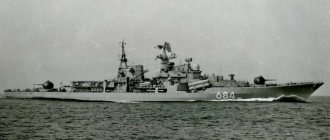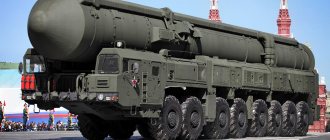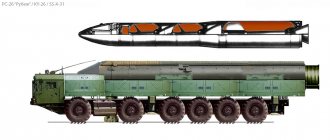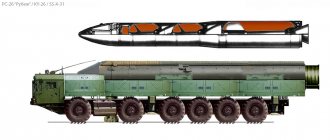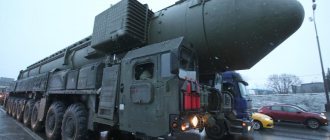Performance characteristics (TTX)
Overall dimensions, m:
- the total length of the rocket is 21.5;
- diameter of the transport and launch container - 2;
- head size - 2.1;
- first stage - 8.1, body diameter - 1.8;
- second stage - 4.6, body diameter -1.55;
- third stage - 3.9, body diameter - 1.34.
During combat patrols, the special missile complex covers an area of 125,000 square kilometers. The maximum firing range of the Topol-M is about twelve thousand kilometers. At launch, the rocket has a total mass of 45 tons, while the weight of the warhead is one ton, and the loaded first stage of the ballistic missile weighs 27.8 tons.
The power of a single charge is 0.55 megatons, the weapon's range is from 150 to 200 meters. The eight-axis MZKT-79221 base is used as a mobile type launcher.
On the way to the fifth generation
In an interview with the Krasnaya Zvezda newspaper (issued December 15, 2017), the head of the Strategic Missile Forces, Sergei Karakaev, said that the Strategic Missile Forces, as before, use the potential of mobile and silo-based complexes approximately equally.
“Of course, the high mobility of mobile systems provides them with significantly greater survivability compared to stationary ones, the coordinates of which are well known. But this does not mean at all that we give preference to the mobile component. I repeat that today the ratio of deployed stationary and mobile launchers in the group is approximately equal,” Karakaev explained.
According to him, the Strategic Missile Forces currently have about 200 mobile launchers in service. We are talking about the RT-2PM Topol, RT-2PM2 Topol-M and the newest 15P155M complexes with the RS-24 Yars missile. Karakaev emphasized that currently it is the Yars mobile complexes that form the basis of the mobile group of the Strategic Missile Forces.
“Compared to the previous similar complex “Topol”, the survivability of “Yars” has been increased several times. And this is not the only advantage of Yars. This complex has greater security, stability of the control system and is less noticeable to technical reconnaissance equipment,” Karakaev noted.
The silo-based grouping is dominated by the R-36M “Voevoda” complex developed by the Yuzhnoye Design Bureau (Dnepropetrovsk), which in the West was nicknamed “Satan,” and the UR-100N “Stiletto” OKB-52 (now NPO Mashinostroeniya, Reutov near Moscow). Both complexes will be in service for several years after 2022.
As Karakaev said, “Voevoda” will be on combat duty until 2024 with the possibility of extending its service life until 2025-2027. According to him, this will ensure “the timely re-equipment of missile regiments with a promising heavy-class missile system.”
In the future, the Stiletto complex will be replaced by the silo-based Yars, and the Voevoda will be replaced by the RS-28 Sarmat, the first throw tests of which are scheduled for the end of December 2022.
It is expected that the warheads of both new systems will be able to overcome even the most powerful missile defense system. At the same time, experts and the military call “Sarmat” the most revolutionary development.
“Sarmat” is a liquid-fueled intercontinental missile that carries a fairly large payload, has a launch range comparable to “Voevoda”, but at the same time spends less time overcoming the active part of the trajectory due to very good energy. The potential enemy’s missile defense systems will have a much harder time,” Deputy Defense Minister Yuri Borisov said in October.
The founder of the Military Russia portal, Dmitry Kornev, believes that some of the Sarmatovs will be equipped with controlled hypersonic warheads Yu-71 (product 4204). In a conversation with RT, he noted that the technical characteristics of the latest weapons are classified.
However, the expert community is confident that the Yu-71 is designed to be guaranteed to overcome the promising US missile defense system.
“I think that by the end of the year, as the Ministry of Defense promises, we will see a throw-in launch of the Sarmat. The first prototype of a heavy liquid-propellant ballistic missile will likely be tested. At the end of 2022 or at the beginning of 2022, “Sarmat” may go on flight tests,” Kornev suggested.
Description of the complex
The Topol-M rocket incorporates all the innovations in rocket science and all the best in the scientific and technical sector of our country’s development. According to many experts, everything related to this project can be summed up in one term: “For the first time.”
Almost all the differences from the first model are inherent in the process of delivering the warhead to the target.
They hide in a system of stable flight and penetration through the countermeasures of a potential enemy. The active phase of the rocket's flight has been reduced due to improvements in the propulsion engines. And the control devices make its trajectory difficult to determine for enemy detection means. The guidance system has also been improved; it has become insensitive to powerful electromagnetic pulses.
The rocket has three stages. All of them are solid fuel, created from composite materials according to the Cocoon project. Control is carried out by tilting the nozzles of the main engine. The body is coated with a special coating with a high content of rare elements. The control circuit cables are covered with a special protective casing and shielded from all types of radiation.
The control system of the Topol-M complex is created on the basis of a high-power digital on-board computer and a gyro-stabilized platform with command gyroscopic devices. An element base has been installed that increases survivability in conditions of a nuclear explosion.
The warhead is detachable, designed as a monoblock type, and contains a thermonuclear charge with a power of 550 kt in TNT equivalent.
Can be equipped with a block-type split warhead. The number of blocks varies from 3 to 7. Each block has a personal guidance system.
The missile defense system installed on this instance consists of:
- active and passive decoys. Moreover, they are practically indistinguishable from the original in all tracking ranges along the entire flight path. In the atmospheric portion of the trajectory, they can confidently overcome high-resolution radars. It consists of 15 to 20 targets of the “Waveship” class;
- means of distorting characteristics. They consist of a combination of various coatings and active noise generators, dipole reflectors and aerosols. Affect enemy detection means;
- trajectory correction engines. They create a chaotic movement of the warhead towards the target, making it difficult to target countermeasures systems.
A rocket launch is similar to a mortar shot - vertically upward. This provides additional security for a complex technical control system.
After the rocket exits the TPU, the first stage engine starts. The warhead itself is moving along the descending branch of the trajectory.
History of creation
It is known that the first developments of the new special complex began in the mid-80s. last century. However, the official decree on the start of work on this project was dated September 1989. An order was received from the state commission to create two types of weapons at once: stationary and mobile. As well as an intercontinental ballistic missile, consisting of three stages, running on solid and liquid fuel.
The project received the special name “Universal”, and in the documents the complex weapon was listed under the code name RT-2PM2.
First developments
The solution to this problem was entrusted to two engineering and production organizations - Yuzhnoye Design Bureau in Dnepropetrovsk and the Institute of Thermal Engineering in Moscow (MIT). It was assumed that, despite the required high degree of unification, the missile mechanisms for mobile and silo-type weapons would still have some differences:
- Weapons marked 15Zh65, stationary, were to be powered by a liquid-fuel jet engine running on the innovative Pronit fuel.
- The mobile special complex was equipped with a rocket (15Zh55) with a solid fuel installation.
The transport and launch container for both types also had to be different. For the first type - a metal structure with special devices for securing various elements of ground systems. For a mobile device - made of fiberglass.
Topol M
In April 1992, the Yuzhnoye Design Bureau interrupted its participation in joint developments, which is why MIT became the main design bureau of the project. Based on the results already obtained, it was decided to continue the creation of a special missile complex, which received the new name Topol-M. It was planned to equip the completely unified weapon with a device operating on solid fuel.
Testing of the new model began in the winter of 1994. For this purpose, an installation located in a shaft at the Plesetsk cosmodrome was used.
After that, the development of a mobile type of weapon (mobile ground-based missile system - PGRK) was continued, the first tests of which took place in the fall of 2000.
Interesting. It is believed that the operating life of Topol-M is 15 years. However, in the fall of 2005, it was decided to carry out a combat training launch of weapons that had been in use for more than 20 years. It was necessary to check the reliability and security of all systems and devices.
The launch took place at the space airfield in Plesetsk, in the direction of the test site in Kamchatka (Kura). The intercontinental ballistic missile was able to hit a conditional target located at the test site with the required accuracy. This was the first time that this type of weapon had been used for such a long time.
Production
After successful tests (four launches of ballistic weapons were carried out), in 1997 the missile system for silo use was put into production. And in 2000, after approval by the State Commission, an order was signed to accept Topol-M for service.
- The production of the head part, as well as combat mechanisms, was carried out by the Russian Federal Nuclear Center in the city of Sarov. Topol-M control systems were created by the St. Petersburg Optical-Mechanical Association "Lomo" and the Research and Production Center for Automation and Instrumentation named after Academician N. A. Pilyugin in Moscow.
- The development of drives was entrusted to the All-Russian Scientific Research Institute "Signal" in Kovrov, as well as the Lyubertsy plant named after. A.V. Ukhtomsky.
- The design of the launch rocket launcher and basic structures was carried out by the Federal Center for Dual Technologies "Soyuz".
- The development of starting mechanisms and support vehicles was carried out by the Federal Research and Production, and their production was carried out by the Barricades production association.
- The creation and re-equipment of ready-made launchers in the mines was entrusted to the Vympel Design Bureau in Moscow together with the Obukhov Plant in St. Petersburg.
The Moscow Central Research Institute of Special Machine Building was involved in the production of composite containers.
Accommodation
In the winter of 1997, two 15Zh65 warheads for a stationary type complex (15P065-35) were delivered to the 140th regiment of the Strategic Missile Forces of the 60th missile division, located in the town of Tatishchevo. And twelve months later, this regiment, with ten launchers (silos), armed with surface-to-ground ballistic weapons (ICBMs), became a combat guard. From 1999 to 2005, four more regiments with silos entered the base.
The deployment of mobile radio stations began in the fall of 2005. Such devices were delivered to the 321st missile regiment. And in 2006, the President of the Russian Federation signed a new program, including the rearmament of some units, for the period until 2015. This plan provided for the acquisition of 69 mobile Topol-M units.
Loading the Topol-M intercontinental ballistic missile into the silo
Interesting. The RT-2PM2 intercontinental ballistic complex served as a prototype for the creation of a space launch vehicle of the Start conversion type. Its launch takes place at the Svobodny and Plesetsk space airfields.

